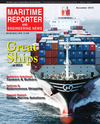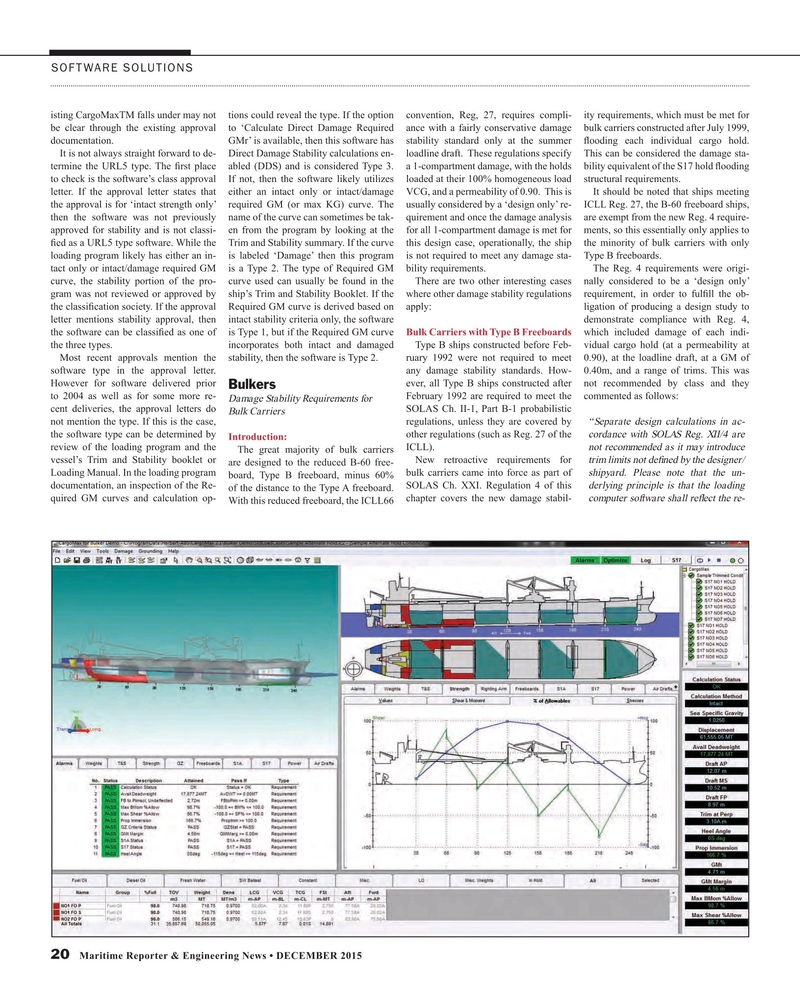
Page 20: of Maritime Reporter Magazine (December 2015)
Great Ships of 2015
Read this page in Pdf, Flash or Html5 edition of December 2015 Maritime Reporter Magazine
SOFTWARE SOLUTIONS isting CargoMaxTM falls under may not tions could reveal the type. If the option convention, Reg, 27, requires compli- ity requirements, which must be met for be clear through the existing approval to ‘Calculate Direct Damage Required ance with a fairly conservative damage bulk carriers constructed after July 1999, documentation. GMr’ is available, then this software has stability standard only at the summer ? ooding each individual cargo hold.
It is not always straight forward to de- Direct Damage Stability calculations en- loadline draft. These regulations specify This can be considered the damage sta- termine the URL5 type. The ? rst place abled (DDS) and is considered Type 3. a 1-compartment damage, with the holds bility equivalent of the S17 hold ? ooding to check is the software’s class approval If not, then the software likely utilizes loaded at their 100% homogeneous load structural requirements. letter. If the approval letter states that either an intact only or intact/damage VCG, and a permeability of 0.90. This is It should be noted that ships meeting the approval is for ‘intact strength only’ required GM (or max KG) curve. The usually considered by a ‘design only’ re- ICLL Reg. 27, the B-60 freeboard ships, then the software was not previously name of the curve can sometimes be tak- quirement and once the damage analysis are exempt from the new Reg. 4 require- approved for stability and is not classi- en from the program by looking at the for all 1-compartment damage is met for ments, so this essentially only applies to ? ed as a URL5 type software. While the Trim and Stability summary. If the curve this design case, operationally, the ship the minority of bulk carriers with only loading program likely has either an in- is labeled ‘Damage’ then this program is not required to meet any damage sta- Type B freeboards.
tact only or intact/damage required GM is a Type 2. The type of Required GM bility requirements. The Reg. 4 requirements were origi- curve, the stability portion of the pro- curve used can usually be found in the There are two other interesting cases nally considered to be a ‘design only’ gram was not reviewed or approved by ship’s Trim and Stability Booklet. If the where other damage stability regulations requirement, in order to ful? ll the ob- the classi? cation society. If the approval Required GM curve is derived based on apply: ligation of producing a design study to letter mentions stability approval, then intact stability criteria only, the software demonstrate compliance with Reg. 4, the software can be classi? ed as one of is Type 1, but if the Required GM curve Bulk Carriers with Type B Freeboards which included damage of each indi- the three types. incorporates both intact and damaged Type B ships constructed before Feb- vidual cargo hold (at a permeability at
Most recent approvals mention the stability, then the software is Type 2. ruary 1992 were not required to meet 0.90), at the loadline draft, at a GM of software type in the approval letter. any damage stability standards. How- 0.40m, and a range of trims. This was
However for software delivered prior ever, all Type B ships constructed after not recommended by class and they
Bulkers to 2004 as well as for some more re- February 1992 are required to meet the commented as follows:
Damage Stability Requirements for cent deliveries, the approval letters do Bulk Carriers
SOLAS Ch. II-1, Part B-1 probabilistic not mention the type. If this is the case, regulations, unless they are covered by “Separate design calculations in ac- the software type can be determined by Introduction: other regulations (such as Reg. 27 of the cordance with SOLAS Reg. XII/4 are review of the loading program and the The great majority of bulk carriers ICLL). not recommended as it may introduce vessel’s Trim and Stability booklet or are designed to the reduced B-60 free-
New retroactive requirements for trim limits not de? ned by the designer/
Loading Manual. In the loading program board, Type B freeboard, minus 60% bulk carriers came into force as part of shipyard. Please note that the un- documentation, an inspection of the Re- of the distance to the Type A freeboard. SOLAS Ch. XXI. Regulation 4 of this derlying principle is that the loading quired GM curves and calculation op- chapter covers the new damage stabil- computer software shall re? ect the re-
With this reduced freeboard, the ICLL66 20 Maritime Reporter & Engineering News • DECEMBER 2015
MR #12 (18-25).indd 20 12/4/2015 11:31:42 AM

 19
19

 21
21
